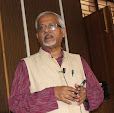
The social program must form an essential part of the concept of Science Conclave, as it offered numerous opportunities for encounters and dialogue between young researchers and Nobel laureates, said Justice Markandey Katju at IIIT-A.
CJ: Arindam Roy, 22 Dec 2008 Views: 1086 Comments: 1
IT WAS final curtains for Asia’s first Science Conclave organised at Indian Institute of Information Technology – Allahabad (IIIT-A), on Sunday (Dec 22), at the Jhalwa campus, with a happy note.
Supreme Court judge, Justice Markandey Katju, speaking as the chief guest at the valedictory session held in the pandal asked the scientists to pay their equal attention towards social science for all-round development of the society.
Illustrating the things in depth, he successfully elaborated all the aspects of economics in collaboration with science to the students. He sought integration of social studies with science. “The social program must form an essential part of the concept of Science Conclave because it offered numerous opportunities for encounters and dialogue between young researchers and Nobel laureates and also between the young scientists themselves,” he said.
Elaborating the worldwide market recession, Justice Katju said if we fail to solve this crisis then despite having good science degrees, students remain out of jobs. Therefore, he urged the scientific fraternity to think over this critical aspect and then develop most appropriate technology in the country.
He suggested that scientists to help in making product strong and cost effective. He called upon the scientists to join hands in overcoming from the economic recession.
He asked the science students to give equal emphasis on reading economics, social science and other books, so that it may help in broadening of their thought process. This spectrum of thinking will increase resulting in the opening of new scientific thinking towards the challenging aspects of economic recession.
Elucidating the concept of Science Conclave, the IIIT-A director Dr MD Tiwari said that it was in the wake of promoting the scientific temperament and invigorating the studies and researches of sciences after the World War II that successful efforts were made at Lindau, Germany where since 1951, meetings of Nobel laureates had been continually held by the Council for Lindau Nobel Laureate meetings and Foundation Lindau Nobel Prize winners meetings at Lake Constance.
“In every meeting, about 20-30 Nobel laureates participate and some 500-700 students and young researchers come from all over the world to listen to the laureates' lectures and engage in discussions with them in an open and informal setting. Representatives of universities and academic institutions select participants based on strict criteria provided by the Council”.
Dr Tiwari further said that IIIT-A Science Conclave provided all participants with exceptional opportunities to take part in valuable scientific and personal contacts, cutting across national and cultural boundaries. The concept of bringing together Nobel laureates and students / young scientists in a relaxed and informal atmosphere remained the key denominator for the success of the meetings.
These unique events also attracted regularly many representatives of the media and their reports encouraged a dialogue between science and society. All contributed to a general understanding of science, a demand of increasing importance to the society. This meet provided a globally recognised forum for exchange of knowledge between Nobel laureates and young researchers.
In the morning session Dr. D.N. Talwar head of the department of Physics, Indiana University, Pensivliyana, US, addressed the students. He talked about nanotechnology and its implementations in daily life and technology. He illustrated the things by examples of Cathedral in Paris, Blue Mosque in Istanbul and strongest sword. He told how in the ancient time also this technology was in existence. That is how they were able to make coloured glasses, which never faded with passing time, even six centuries.
Talking about the strongest sword, he said that it was made of wootz steel, the composition of which we have come to know recently. All the colour effect he said were because of plasmonic effect and a new emerging field of science is coming up called nanophotonics.
Prof M Radhakrishna organising committee member informed as many as 1113 students comprising 984 students (659 male, 295 female), 146 teachers (122 male and 24 female) took part in the Science Conclave.
The PRO Pankaj Mishra’s initiative helped in wide coverage of the event in print, TV and the only online media, merinews.com.
The cultural evening saw Shovana Narayan present her vivid classical, dance while main attraction of the Saturday evening were noted Gazal singer duet Bhupendra and Mitali. They enthralled the audience rendering melodious gazals and Hindi film songs. It was their first visit to the city. They promised to come again, in the Sangam city, where knowledge, myth and history confluence.
(http://www.merinews.com/catFull.jsp?articleID=154214 )












No comments:
Post a Comment